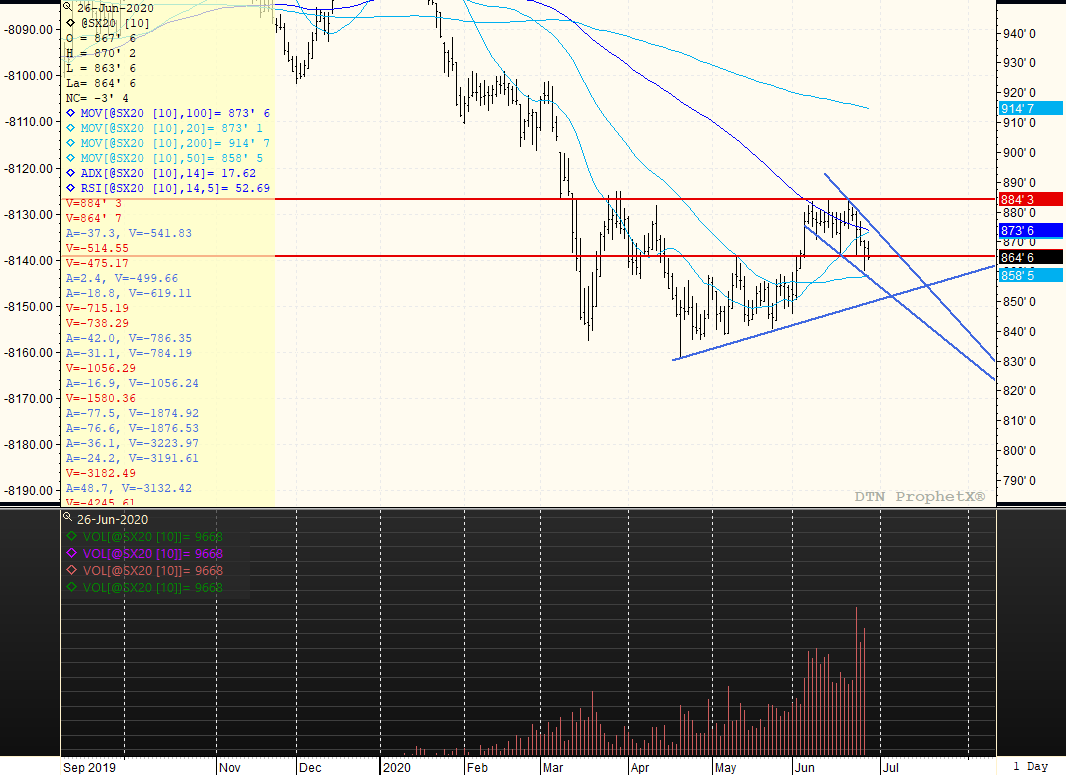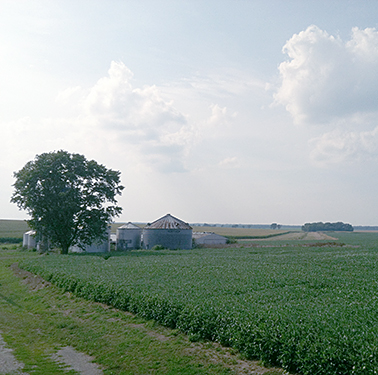SPREADS
Sep. crush falls to 79.38c/bu while oilsahre trades steady at 32.60%. July/Dec corn widens back out to 11 1/4c with July/Sep. weaker at 3 3/4c from 2 3/4c. July/August bean spread still retains an inverse of 1 3/4c from 3/4c while July/August trades 3c inverse to 2 1/2c. Sep wheat/corn trades 1.64 1/4c.
PALM OIL
Sep. down 27 ringgits down 1% ith inventories projected to peak well above 3 mmt by the end of the year as demand weakens due to worldwide recession, while steady production continues, according to James Fry, chairman of LMC International.
NEWS
Stocks are down 200 pts in quiet trade as May consumer spending rose a record 8.2% as the economy is growing once again. Crude oil prices fall to $38.12/barrel with the US dollar trading up to 97.48.
CALLS
Calls are as follows:
beans: 2 -4 lower
meal: .60-.80 lower
soyoil: 8-10 lower
corn: steady
wheat: 2 1/2-3 lower
canola: .80-1.00 higher
BUSINESS
USDA reports 132,000 mt of beans sold to China for 20/21
TECHNICALS
September Corn: Prices fall towards the lowest end of prices and near ctr lows of $3.17 1/2. There is not much back support at $3.17 and resistance moves down to $3.22. Would look for another test at the lows of $3.17 1/2 with the major direction now lower from sideways. RSI is not oversold at 41% which allows prices to break easier as well.
first support: $3.18
resistance: $3.22/$3.24
possible range: much the same or lower
September Wheat: Major direction is lower and prices are sitting close to key support which has offered up trendline support and congestion around $4.83. Therefore, if prices open and break $4.83 would look for the possibility of targeting a new trading range low under $4.81 at $4.75/$4.77. New resistance has formed on the last bounce from $4.90-$4.94 which could suggest a further break is coming.
first support: $4.83
resistance: $4.89/$4.90
possible range: much the same or lower
November Beans: Trading range has been extended to the downside as prices test $8.60, from recent highs at $8.80. On a weaker start prices could test $8.56/$8.58, which has been the recent low on a break under $8.60. If short, would use breaks to cover something, as the market has been an $8.50-$8.80 trade in the big picture.
trendline support: $8.58
resistance: $8.68/$8.71
possible range: much the same
December Meal: Overall trading range is from $290.00-$301.00. However, resistance is building on the chart from $294.00-$295.00, which signals that another larger break could be coming. The chart begins on key support at $292.00, and a break of this level opens the door to a test of $290.00 with a possible target low of $287.50 if $290.00 is violated.
key support: $292.00
resistance: $294.00
possible range: $291.00-$294.00
December Soyoil: Overall trading range is from 28c-2950c. Double lows are now located from 2820-2830c. Best support is under the market at 2790c-28c should we go there. If short, would cover something in at 28c and try the long side of the market.
first support: 2815c-2820c
resistance: 2850c
possible range: much the same
NOVEMBER BEANS
The market had been trapped between $8.65-$8.80 (red lines) since the beginning of June, but recently broke the lower end of support while building resistance with repeated failure to overcome tops at $8.80. The overall weakness and new downtrend channel forming suggests that prices could break down further to test the channel support at $8.58, and the 50-day moving average at $8.56. Should prices go there, would elect to cover in a short position or try the long side of the market with a tight sell-stop. Prices are adjusting slightly lower in lieu of a quiet export pace and good weather. Look to perhaps head into an adjusted $8.50-$8.80 trading range.

TAGS – Feed Grains, Soy & Oilseeds, Wheat, North America


 Wheat remains the star of the ag commodity space this week with the rally continuing on challenging weather prospects for the U.S. HRW region, Europe, and the Black Sea. Until a few weeks ago, there were few doubts about the 2024 crop being able to supply the expected demand, but now reduced yi...
Wheat remains the star of the ag commodity space this week with the rally continuing on challenging weather prospects for the U.S. HRW region, Europe, and the Black Sea. Until a few weeks ago, there were few doubts about the 2024 crop being able to supply the expected demand, but now reduced yi...
 Most Apparent Solution The EU’s organic sector wants the bloc’s officials to take more action to ensure they achieve the target of 25 percent of agricultural output being organic by 2030. Specifically, they want a campaign to increase consumer demand for organic food so that organic...
Most Apparent Solution The EU’s organic sector wants the bloc’s officials to take more action to ensure they achieve the target of 25 percent of agricultural output being organic by 2030. Specifically, they want a campaign to increase consumer demand for organic food so that organic...
 Yesterday, the Animal and Plant Health Inspection Service (APHIS) issued a federal order requiring testing and reporting of highly pathogenic avian influenza (HPAI) for the interstate movement of lactating dairy cattle. Specific guidance will be issued at some point today, and the order will go...
Yesterday, the Animal and Plant Health Inspection Service (APHIS) issued a federal order requiring testing and reporting of highly pathogenic avian influenza (HPAI) for the interstate movement of lactating dairy cattle. Specific guidance will be issued at some point today, and the order will go...